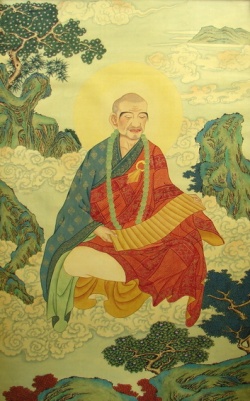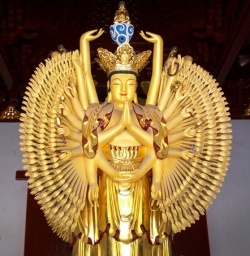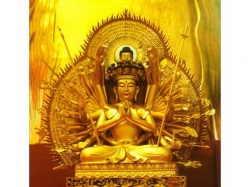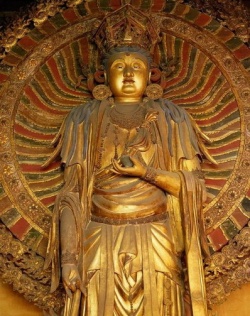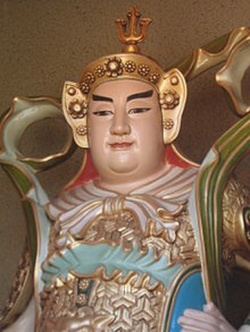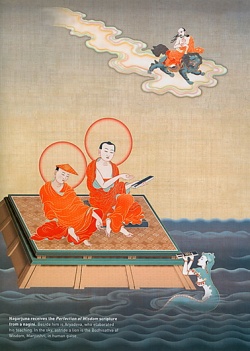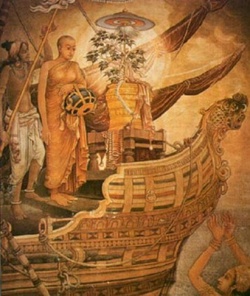Introduction to Yogacara Buddhism: Asanga, Vasubandhu and Hsuan-Tsang
by Thomas Tam, Ph.D., M.P.H June 4, 2004 Asian American / Asian Research Institute The City University of New York
Hsuan sang, the famous Chinese monk from the Tang dynasty, traveled from China to India to learn Yogacara Buddhism. He crossed deserts, mountains, rivers and spent eighteen years before his triumphant return to his country and began the daunting task of translating the sutras and commentaries that he brought back. One of the most important exposition, “Vijnaptimatratasiddhi-Trimsika”, was written by Vasubandhu who, together with his brother, Asanga, established and developed the teachings of Yogacara Buddhism. The Vijnaptimatratasiddhi-Trimsikai By Vasubandhu Translated by Wei Tatiii
Verse 1 Concepts of Atman and dharmas do not imply the existence of a real Atman and real dharmas, but are merely fictitious constructions [produced by numerous causes). Because of this, all varieties of phenomenal appearances and qualities arise.
The phenomena of Atman and dharmas are [all mental representations] based on the manifestation and transformation of consciousness. Consciousnesses capable of unfolding or manifesting themselves may be grouped in three general categories:
Verse 2 (1) The consciousness whose fruits (retribution) mature at varying times (i.e., the eighth or ‘Storehouse’ consciousness or Alayavijnana); (
2) the consciousness that cogitates or deliberates (i.e., the seventh or thought-centre consciousness or Manas); And
(3) the consciousness that perceives and discriminates between spheres of objects (i.e., the sixth or sense-centre consciousness or Manovijnana and the five sense consciousnesses.
The first is the Alayavijnana (i.e., storehouse or repository consciousness).
It is also called Vipakavijnana (retributive consciousnessx) and Sarvabijakavijnana (the consciousness that carries within it all Bijas or seeds). [It brings to fruition all seeds (effects of good and evil deeds).]
Verse 3 It is impossible to comprehend completely
(1) what it ‘holds and receives’.
(2) Its ‘place’ or ‘locality’, and
(3) its power of perception and discrimination.
It is at all times associated with five mental attributes (caittas), namely, mental contact, Thomas Tam, © 2004 Attention, sensation, conception, and volition. But it is always associated only with the ‘sensation of indifferencex’.
Verse 4 It belongs to the ‘non-defiled-non-defined moral species’. The same is true in the case of menta contact and so forth. It is perpetually manifesting itself like a torrent, And is renounced (i.e., it ceases to be called the Alaya) in the state of Arhats(the state of the saint who enters Nirvana).
Verse 5 Next comes the second evolving consciousness. This consciousness is called Manas.
It manifests itself, with the Alayavijnana as its basis and support, and takes that consciousness as its object. It has the nature and character of cogitation or intellect.
Verse 6 It is always accompanied by four kleshas or vexing passions (sources of affliction and delusion), Namely, Self-delusion, Self-belief Together with Self-conceit and Self-Love, It is also accompanied by the other mental associates (caittas), namely, mental contact and so forth (attention, sensation, conception, and volition).
Verse 7 It belongs to the ‘defiled non-defined moral species’ (neither good nor bad but defiled). It is active in the dhatu or bhumi in which the sentient being is born and to which he is bound. It ceases to exist at the stage of Arhatship, in the ‘meditation or annihilation’ (state of complete extinction of thought and other mental qualities), And on the supramundane path.
Verse 8 Next comes the third evolving consciousness Which is divided into six categories of discrimination. Their nature and character consist of the perception and discrimination of spheres of objects. Thomas Tam, © 2004
They are good, bad, and neither good nor bad.
Verse 9 They are associated with the universal caittas,
The special caittas,
the good caittas,
the klesas (vexing passions or mental qualities),
The upaklesas (secondary vexing passions or mental qualities), and the Aniyatas (indeterminate mental associates).
They are all associated with the three sensations
Joy,
sorrow, and
indifference.
Verse 10 First, universal caittas, mental contact and so forth (attention, sensation, conception, volition). Next, special caittas, that is, desire. Resolve, memory, meditation, and discernment. The objects perceived by the special caittas are particular and varied.
Verse 11 The good caittas refer to belief, sense of shame, sense of integrity, The three roots of non-covetousness and so forth (non-anger and non-delusion), Zeal or diligence, composure of mind, vigilance, Equanimity, and harmlessness or non-injury.
Verse 12 The klesas are covetousness, anger, Delusion, conceit, doubt, and false views.
The upaklesas (secondary vexing passions) are
(1) fury;
(2) Enmity;
(3) concealment or hypocrisy
(4) vexation;
(5) envy;
(6) parsimony;
Verse 13
(7) Deception;
(8) duplicity or fraudulence; (with)
(9) harmfulness;
(10) pride;
(11) Shamelessness;
(12) non-integrity;
(13) Agitation or restlessness; (with)
(14) torpid-mindedness;
(15) Unbelief;
(16) indolence;
Verse 14
(17) Idleness;
(18) forgetfulness;
(19) Distraction; and
(20) non-discernment or thoughtlessness.
The indeterminate mental qualities refer to remorse, drowsiness, Reflection, and investigation; these two couples can be of two kinds.
Verse 15 In dependence upon the root consciousness (i.e., the eighth consciousness, Alayavijnana) The five consciousnesses (of the senses) manifest themselves in accordance with various causes and conditions, Sometimes together, sometimes separately, Just as waves manifest themselves in dependence upon the conditions of the water.
Verse 16 But the sixth consciousness (Manovijnana) manifests itself at all times, Except for beings born into the ‘heavenly world without thought’ (among Asamjnidevas in whom thinking has entirely ceased), Except also for those in the two mindless Samapattis (two forms of meditation in which there is no more activity of thought) and Those who are in states of stupor or unconsciousness.
Verse 17 The various consciousnesses manifest themselves in what seem to be two divisions: Perception and the object of perception. Because of this, Atman and dharmas do not exist. For this reason, all is mere consciousness.
Verse 18 From the consciousness which contains all Bijas (seeds) (the Alayavijnana) Such-and-such evolution or transformation takes place. Through the force of the mutual co-operation of the actual Dharmas Such-and-such kinds of distinction are engendered.
Verse 19 Owing to the habit-energy (Bijas) of various previous deeds, Together with the habit-energy of the two ‘Apprehensions’, As previous retribution (karma of previous existences) is exhausted, Succeeding retribution (maturing in subsequent existences) is produced.
Verse 20 Because of such and such imaginations, Such and such things are imagined, [i.e., conceived by the imagination). What is conceived by this imagination Has no nature of its own.
Verse 21 The self-nature which results from dependence on others Consists of discrimination's produced by causes and conditions.
The difference between the nature of Ultimate Reality and the nature of dependence on others Is that the former is eternally free from the parikalpita-nature (conception by the imagination) of the latter, that is, the dependence on others for manifestation.
Verse 22 Thus, the nature of Ultimate Reality and the nature of dependence on others Are neither different nor non-different, Just as impermanence is neither different nor non-different from impermanent dharmas. One does not perceive the nature of dependence on others as long as one has not perceived that of Ultimate Reality).
Verse 23 On the basis of the three natures of existence Are established the three natures of non-existence. For this reason the Buddha preached, with a secret intention, That all dharmas have no nature of their own.
Verse 24 The first is non-existence as regards characteristics [since they are but products of the imagination). The second is non-existence as regards innate nature or origination [since it is the result of discrimination]. The last is non-existence as regards the supreme truth about all dharmas which is far removed from the first ‘nature of mere-imagination’, In which things are believed to be a real Atman and real dharmas.
Verse 25 The supreme truth about all dharmas. Is also Bhutatathata (chen-ju, genuine thusness, absolute reality), Because it is immutable, remaining constantly thus in its nature. This is the true nature of Mere-consciousness.
Verse 26 As long as the consciousness (of wisdom) has not arisen To seek to abide in the state of Vijnaptimatrata, The ‘attachment’ and ‘drowsiness’ arising from the two ‘apprehensions’ Cannot, as yet, be suppressed and obliterated.
Verse 27 As long as one places something before himself and, taking it as an object, Declares that it is the nature of Mere-consciousness, He is really not residing in the state of Mere-consciousness, Because he is in possession of something.
Verse 28 If, in perceiving the sphere of objects, Wisdom no longer conceives any idea of the object, Then that wisdom is in the state of Vijnaptimatrata, Because both the object to be apprehended and the act of apprehending by consciousness are absent.
Verse 29 Without perception, inconceivable and incomprehensible, This is transcendental supramundane wisdom, Because of the abandonment of the crude dross of the two barriers, Inner transformation into perfect wisdom is achieved.
Verse 30 This is the Pure Dhatu (the undefiled storehouse realm) Which is inconceivable and incomprehensible, good and eternal, Where one is in a state of blissfulness with one’s emancipated body; This is the Law of “Great Silence” (mahamuni), the Dharmakaya, realized by the great Buddha, Sakyamuni.
Notes: (The Vijnaptimatratasiddhi-Trimsika, written by Vasubandhu around the fourth century, is a central text for Yogacara Buddhism, which was started by his brother, Asanga. Commentaries written by ten of Vasubandhu’s disciples were merged and translated in a book, Ch’eng Wei-Shih Lun, by Hsuan Chuang after he came back from India to China in the T’ang dynasty.
Some of the following notes come from Rev. Tai Hsu’s lectures on the Vijnaptimatratasiddhi-Trimsika.
The responsibility of all misinterpretations must be borne by the presenter, Thomas Tam, alone.) i The thirty stanzas on mere consciousness.
Author of the thirty stanzas, and brother of Asanga, who lived around the fourth century. From his translation of Hsuan Chuang’s Doctrine of Mere Consciousness. iv Meaning self. v Meaning things, events, ideas, etc. vi The most fundamental consciousness, where everything resides. Like the Sanskrit word for Himalaya, where snow resides.
The consciousness that differentiates constantly. It grabs onto the store consciousness and considers it to be the self.
The consciousness that differentiates, but not constantly, for example, good or bad, beautiful or ugly. ix Meaning the consciousness of sight, sound, smell, taste, and touch. x Roughly meaning consequences. xi Roughly meaning causes.
A mental attribute is the result of the manifestation of a seed in our store consciousness. xiii The consciousness where there is no sense of suffering or enjoyment. The consciousness that contains all seeds, which cannot be classified as good or evil. xv The state of sainthood where troubles cease to arise. xvi
Nirvana does not mean death. It means peace from the liberation of self. The consideration made by the mind which can result in future consequences. xviii Different levels of existence: human, animal, hell, heaven, etc.
The wisdom that transcend the ordinary world we live in. xx That is, sight, sound, smell, taste, touch, and mind. xxi Remorse and drowsiness is of one kind; reflection and investigation refers to another kind. xxii Name of inhabitants of such a world. xxiii A permanent self or thing does not exist.
The self or thing exists only as perception or objects of perception, both manifestations of consciousness. xxiv The seeds that reside in the store consciousness, seem to be inert, before manifestation. It is changing and growing at every instant, nevertheless. The manifestation of every seed, is also dependent on the cooperation or interaction of other seeds. xxv Habit energy means permeation or impregnation.
Thich Nhat Hanh explained it thus: “If you want to make jasmine tea, you pick jasmine flowers, put them in a box together with the tea, close it tightly, and leave it for several weeks. The fragrant jasmine penetrates deeply into the tea leaves. The tea will then smell of jasmine, because it has absorbed the perfume of the jasmine blossoms. Our store consciousness also has a strong capacity to receive and absorb “fragrances” or “scents”. xxvi
The two apprehensions refer to the insistent grabbing of the self and of appearances. xxvii It is the inability to give up the self and appearances, plus the influences from previous seeds, that the cycle of birth and death continues. xxviii The nature of ultimate reality refers to the giving up of insistent grabbing of the self and appearances. xxix Without experiencing and understanding the nature of ultimate reality, there cannot be an understanding of the nature of dependence on others. In other words, without giving up the self and appearances, one cannot see through the appearance of things and self. The three natures of existence refer to:
1) what is conceived by imagination;
2) dependence on others; 3) ultimate reality. This refers to Buddha’s understanding that people in the world insistently grab onto some permanent nature in the things they encountered. xxxii The three non-existences refer to the impermanent nature of appearance; the inability to reduce something to a first cause; and the unreality of ultimate reality. xxxiii The apprehensions refer to the insistent grabbing of the self and appearances. The two terms ‘attachment’ and ‘drowsiness’ in this stanza, however, should be more appropriately translated as ‘dormant’.Here, ‘perception’ should be replaced by ‘possession’. The two dross barriers refer to ‘knowledge’ and ‘afflictions’. xxxvi It is also known as Pure Consciousness, when it is realized that store consciousness is no longer subject to afflictions, and afflictions are no other than enlightenment. (From Thich Nhat Hanh’s Transformation at the Base: Fifty Verses on The Nature of Consciousness).
